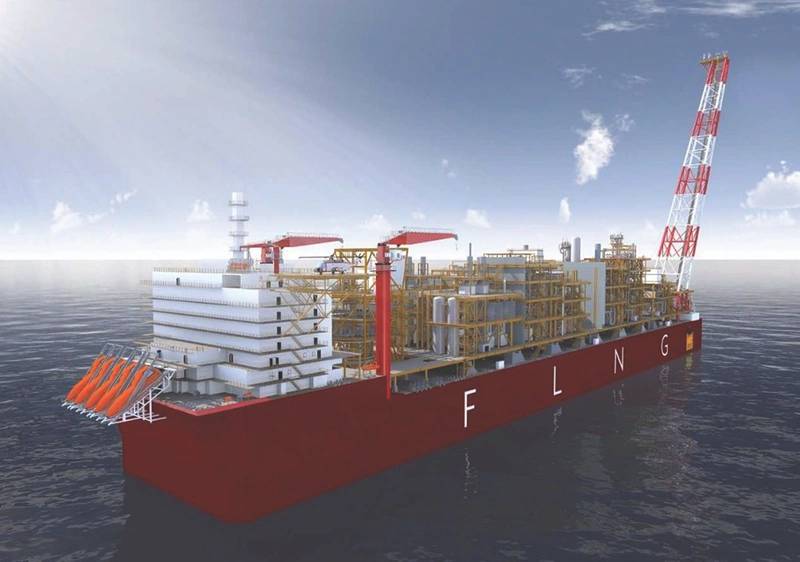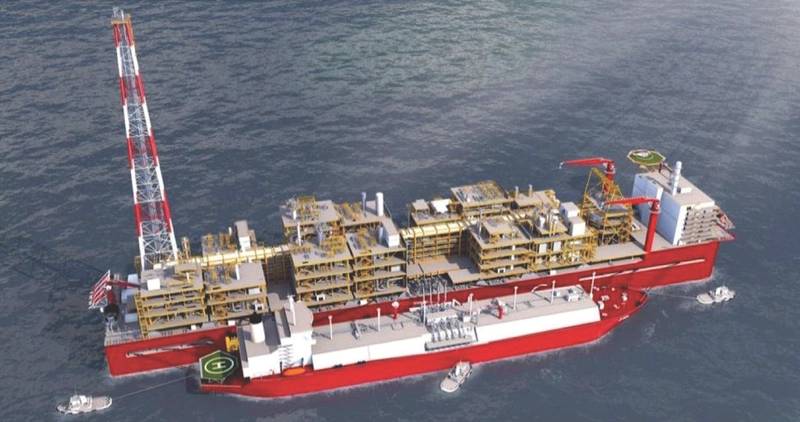
Since the idea of floating liquefied natural gas (FLNG) was first mooted the landscape of the oil and gas sector has changed dramatically. When Shell finally pressed the go button for its Prelude FLNG project offshore Australia back in mid-2011, the oil price was pushing $115 a barrel. By the time it delivered first gas earlier this year it was less than half what it was at final investment decision (FID) eight years earlier, hovering around $55. That price depreciation has made many potential operators have second thoughts on the technology.
The International Energy Agency (IEA) estimates that Africa could overtake Russia as a global gas supplier by 2040, demonstrating the scale of opportunity should these obstacles be overcome. For the region, FLNG has been touted as a potentially lucrative way to avoid onshore facilities with all the associated planning, security and local content issues.
Africa’s first FLNG project, Golar’s Cameroon GoFLNG, shipped its first consignment in 2018, Eni’s Coral South FLNG is under construction in South Korea and Singapore and is expected to start producing in 2022, while BP’s Tortue project was finally given the green light late last year and will also come online in 2022.
However, there was no such good news for Ophir Energy who finally pulled the plug on its Fortuna FLNG project offshore Equatorial Guinea. “Financing of FLNG is always a challenge, given it’s still a new technology, but the main problem with Fortuna was that the banks were unwilling to back an Ophir-led project as opposed to established oil firms like Eni or BP’s projects,” Ed Cox, editor, global LNG at ICIS Energy, says of the Fortuna cancellation.
Challenges for FLNG growth
FLNG is part of the solution to commercialize gas reserves in Africa, but given the production output from all existing and sanctioned projects (BP’s Tortue, Eni’s Coral & Kribi in Cameroon), it is only going to be a minor part of the gas sector in Africa, Cox says. “For now, conventional LNG plants and gas-to-power generation such as in Nigeria and Ghana will continue to play a major role in monetizing African gas reserves.”
Although at present the share of gas produced through FLNG in the market is not significant, it has garnered considerable interest. It has several advantages in its favor. The initial capital investment is lower, and with faster construction, it offers operators access to early cash returns to balance the investment or invest in further production. This is evidenced by the FIDs taken on Coral and Tortue.
However, despite these pluses, there are challenges in developing projects. Chief among these is local content issues. Whereas onshore facilities are constructed using local labor and resources, FLNG construction or conversions are carried out on foreign soil. This has seen governments push for onshore developments, such as Abadi (Indonesia), Greater Sunrise (Timor Leste/Australia) and Tanzania.
There is also the question of appropriate fields for the technology. According to the Global FLNG Overview 2019 report from Wood Mackenzie released earlier this year, the significant reduction in exploration expenditure since the oil price crash in 2014 has yielded few suitable new gas discoveries. The lack of economy of scale is likely to limit FLNG projects to small scale and remote developments. This often requires the FLNG facility to be integrated with the upstream section of the project, resulting in projects of increasing complexity and cost.
Despite these challenges, Africa is playing host to important LNG innovation, but the success of these projects needs collaboration between operators, suppliers and host governments to navigate a challenging LNG market to secure necessary off-take agreements while host governments must ensure that fiscal and regulatory regimes do not become barriers to investment.
 The Coral South FLNG will be the world’s first ultra-deepwater FLNG, operating at a depth of 2,000 meters. It is expected to produce around 3.4 million metric tons of LNG per year. (Image: Eni)
The Coral South FLNG will be the world’s first ultra-deepwater FLNG, operating at a depth of 2,000 meters. It is expected to produce around 3.4 million metric tons of LNG per year. (Image: Eni)
Humble beginnings
It all started for Africa with FLNG Hilli Episeyo, moored offshore Kribi, Cameroon. The conversion of an LNG tanker into an FLNG, the optimization of Sanaga 1 offshore platform and the modification of the Bipaga treatment onshore facilities are at the heart of this project.
Hilli Episeyo was originally a conventional 1975-built, 125,000-cubic-meter (m3) LNG carrier before conversion at the Keppel yard in Singapore in 2015. It is now equipped with four liquefaction trains, each to produce between 500,000 to 700,000 tons of LNG per year with onboard storage of 125,000 m3. LNG carriers with a capacity of 70,000 to 175,000 m3 can be stowed, and the loading is carried out by three transfer arms at a flow rate of 10,000 m3 per hour.
On record as the world’s first converted FLNG vessel, Hilli Episeyo is also Africa’s first and currently only operational FLNG unit. It produced its first LNG from Sanaga field in March 2018 and sent its first cargo in May that year.
Second online will be Eni’s Coral field, discovered in May 2012 and located offshore Mozambique within Area 4. It contains approximately 450 billion cubic meters (16 Tcf) of gas in place. In October 2016, Eni signed an agreement with BP for the sale of the entire volumes of LNG produced by the Coral South project for a period of over 20 years.
The FLNG will operate at a depth of 2,000 meters and is expected to produce around 3.4 million metric tons of LNG per year. Construction started earlier this year with the steel cut for the turret in Singapore. The other main component of the FLNG, the topside modules, will be built in South Korea at the Samsung Heavy Industries shipyards. According to Eni, construction is planned to start at the end of this year and is expected to be completed by the end of 2021. First gas is expected in 2022.
 (Image: Eni)
(Image: Eni)
And then there were three
The Africa FLNG drive received a boost late last year when BP announced the FID for Phase 1 of the Greater Tortue Ahmeyim development. The project will produce gas from an ultra-deepwater subsea system and mid-water floating production, storage and offloading (FPSO) vessel, which will process the gas, removing heavier hydrocarbon components. The gas will then be transferred to an FLNG facility at an innovative nearshore hub located on the Mauritania and Senegal maritime border.
The FLNG facility is designed to provide circa 2.5 million metric tons of LNG per annum on average, with the total gas resources in the field estimated to be around 15 trillion cubic feet. The project, the first significant gas project to reach FID in the basin, is planned to provide LNG for global export as well as making gas available for domestic use in both Mauritania and Senegal.
The vessel conversion would take place in Singapore at the Keppel Shipyard, where Golar’s Hilli Episeyo FLNG that is now operating offshore Cameroon was converted.
“By sanctioning the project now, BP is benefiting from the substantial cost deflation of recent years” Giles Farrer, director global gas and LNG, at Wood Mackenzie, says. “The real value for the project will come once BP and partner Kosmos move forwards with expanding the facility with Phases 2 and 3 in quick succession. These will deliver substantial upstream economies of scale and compelling value.”
There is no word yet from BP, Kosmos or Golar whether phases 2 and 3 will entail further FLNGs.
“FID is another signal of how bullish the LNG market is,” Farrer adds. “Tortue is the third LNG project to take FID this year, and its sanction is the first phase in the establishment of a significant new supply hub in the Atlantic basin.”
With Tortue phase one established, BP’s next step in the region will be to develop the area immediately adjacent. “We are only developing the first phase of gas, but we have already identified enough gas supply for subsequent phases,” Jasper Peijs, vice president of exploration for BP Africa says. “Once step one is done you would immediately look about setting up step two in Greater Tortue.”
“Then, in the nearby Cayar block, there is the Yakaar discovery, which was the largest hydrocarbon discovery by industry in 2017 at around 12Tcf or two billion BOE,” Peijs said. “That, together with the Teranga discovery that Kosmos had already made just to the east of that, puts between 30 and 50Tcf of gas in place. That isn’t proven yet and will require an appraisal. Moreover, that is just in Senegal. In Mauritania we have acquired much seismic data that has been taken through to technical limits with some boutique processing and I’m sure that north of the Tortue gas field we will highly likely find some more gas that’s material and significant, which would entail us looking at the possibility for a southern Mauritania gas hub.”
Where next for Africa FLNG?
Aside from the fields under production, there are other sites in the continent that may be of interest. One potential location is Tanzania, as the Giant Rovuma basin in Mozambique extends there. Shell and Equinor have plans to develop a 10mtpa LNG plant by 2026/2027. “Maybe FLNG could be a potential option in the future,” Cox says. “But as we have seen with the recent cyclone in Mozambique, situating an LNG plant in that location will have weather challenges. This is why Kribi and Tortue (Senegal/ Mauritania) are perfect locations for FLNG projects given the mild nature of the weather patterns along the West African coast.”